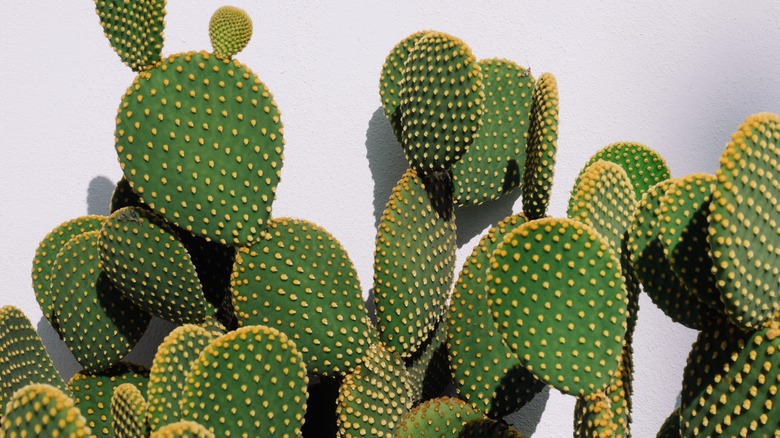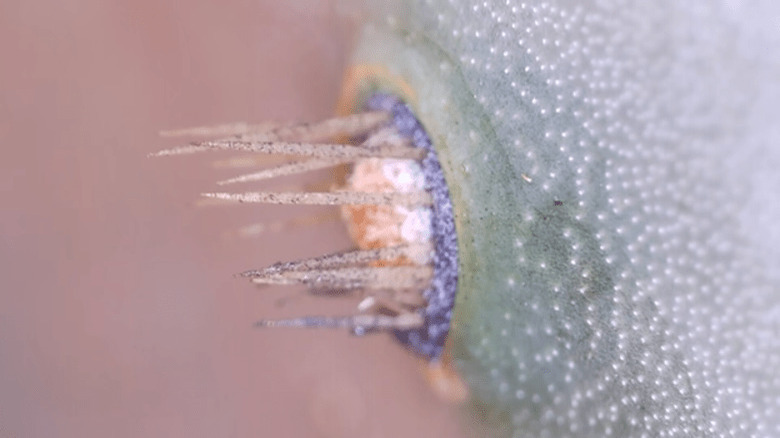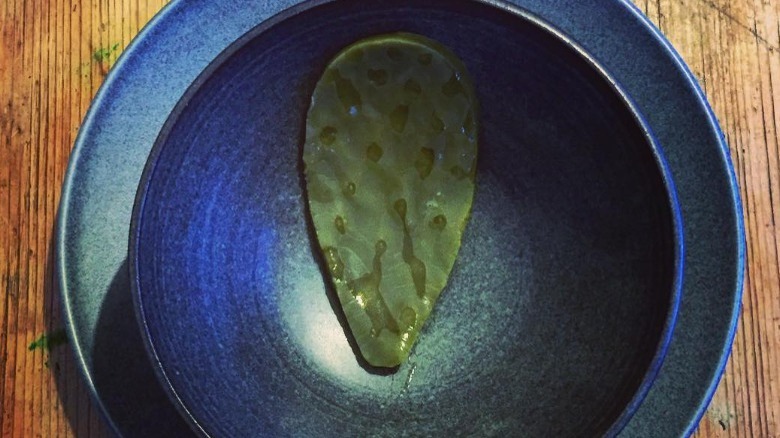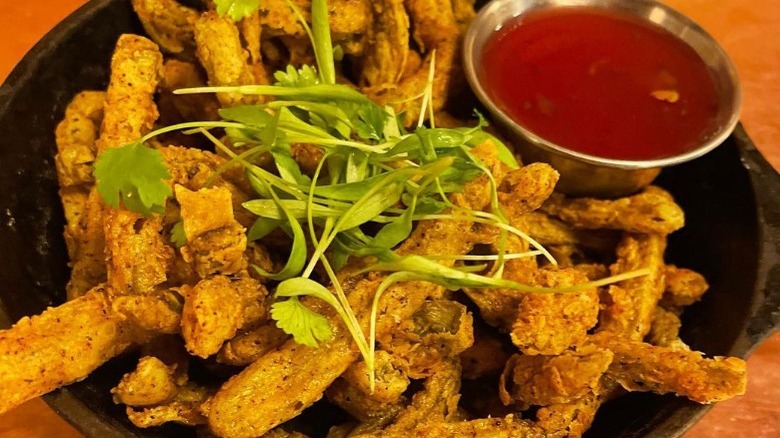This Is The Right Way To Eat Cactus Without Getting Poked
If you grew up in a cactus-free part of the nation and much of your cactus knowledge comes from watching Wile E. Coyote trying to ensnare the Roadrunner, you're forgiven for not thinking of this prickly plant as an obvious food source. After all, to the cactus-eating novice, it would likely be easier to catch the Roadrunner than work your way through a bevy of barbs and spikes.
It turns out that by eschewing this thorny food source, you may be missing out on a culinary treat that offers up a host of nutritional benefits. Yes, those green fleshy paddles (or "nopales" in Spanish) are actually quite good for you. It is important to qualify this pronouncement by adding that when it comes to eating, not all cacti are created equal. Some are, in fact, quite poisonous. The prickly pear cactus (Nopal cactus), however, is perfectly edible and appears to be the culinary cactus of choice. In fact, the Mayo Clinic reveals that it contains an ample dose of fiber, can help lower blood sugars, and may decrease the unpleasant symptoms of a hangover. The Beet adds that these cacti are also an excellent source of antioxidants, essential fatty acids, and vitamin C. Perhaps, the Coyote would have been better off gnawing on a cactus paddle.
While the benefits of eating the Nopal cactus are plentiful, so are the risks, right? After all, you're used to eating smooth things that aren't trying to stab you. So, how do you eat a cactus?
Beware of microscopic thorns
The prickly pear cactus is not as defenseless as it may appear. According to a video by YouTuber, Adam Ragusea, it is actually a "very angry plant." You may think you can simply grab the plant by avoiding its large, obvious spears. Not so. Hiding between these are near invisible spines with barbed ends called "glochidia" that Ragusea refers to as "demons straight from the fires of Hades." He offers that if you try to peel the skin first, you might wind up with several of these spiky things in the plant's flesh. Instead, he says you need to burn them off over a campfire first. That sounds like a lot of work.
Thankfully, Muy Bueno has a solution. Apparently, the paddles sold at the grocery store have most of the thorns removed. Most, not all. The outlet recommends holding the paddle with a dish towel and using a knife to cut "against the grain of the spines." Make sure you remove all the spikes. You will want to use extra care when slicing away the edges and base as they are home to a sizeable thorn population. The University of Wyoming adds that you must take away the "eye" of the thorns, which might involve a bit of cutting and digging. They, then recommend that you thoroughly rinse the paddle and remove at least 1/4 inch of its outer flesh. Leave no prickly hazards behind.
Is the final product worth all this work?
Cacti tastes a bit like okra and asparagus
Before you start hacking away at a plant that appears to be trying to kill you, you may be asking, "What does it taste like?" Here are a few descriptions provided by cactus eaters. Muy Bueno says the paddles are very much like a "lemony green bean had a baby with okra." That's certainly different. Cook Gem agrees with the okra part, adding that the nopales have a hint of sourness but that their overall flavor profile matches that of a green veggie like asparagus. And Foods Guy concurs, likening it to okra or asparagus as well, adding that the texture changes greatly depending on its preparation.
In his YouTube video, Adam Ragusea, shares that the paddles contain mucilage (yes, much like your primary school glue), making it rather slimey like okra. He contends that this sliminess doesn't disturb him when he's eating it raw, but it's a completely different story when it's cooked. Foods Guy adds that the ooze can be decreased depending on how it's prepared, but that it truly is part of the paddle's texture and, therefore, the paddle-eating experience. Mm. Slime.
Still, some cultures love this dish and appear to have grown accustomed to dealing with thorns and gloop. There must be something to it. Perhaps, it is best to try your first bite of cacti by whipping up one of these traditional dishes.
If you love Mexican food, you may love nopales
What are some tasty ways to get your fill of cactus paddles? A glimpse at Yummly, and you'll discover recipes for cactus fries, casseroles, smoothies, and pies. You can even try it candied. Registered Dietician, Krista Linares, told Well + Good that nopales can be used in a plethora of ways. They can be grilled, pickled, added to scrambled egg dishes, and cut up to accompany tomatoes. They even make up this fresh Nopalitos recipe. Remember, they are commonly used in Mexican food and everyone knows that Mexican cuisine is fabulous. Perhaps, this seemingly menacing plant does have a lot to offer.
To get the best nopales from an actual cactus, YouTube content creator Adam Ragusea says to look for the new paddles that appear in the spring as they'll be more tender. If you're buying them at a grocery store, Muy Bueno recommends selecting ones that have a bright green hue, have some give to them, and are wrinkle-free. Stick to ones that are roughly the same size as your mitt as anything bigger may be the cactus equivalent to shoe leather.
You are now prepared to venture into the world of consuming cacti. Yes, you may be a little intimidated and, perhaps, even a tad frightened. But, if you enjoy healthy eating, are a fan of Mexican food, and have an adventurous spirit, this may be a great way to embrace the new year and the novel things that await you.



